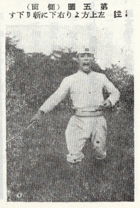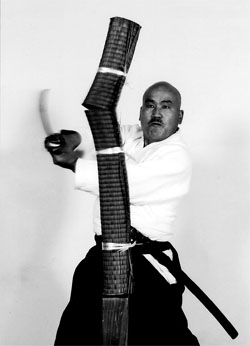.jpg)
Toyama-ryū Battōdō: Military Sword-Drawing
Toyama-ryū Battōdō (戸山流抜刀道), also commonly known as Toyama-ryū Iaidō (戸山流居合道), is a system of swordsmanship developed after World War I for the purpose of training officers of the Imperial Japanese Army in the use of the guntō (軍刀; military sword), which served as a sidearm in a fashion similar to that of the Western military sabre. The techniques of Toyama Ryū are culled from a number of sword traditions, and there is also palpable influence from Western military tradition. Originally a small sub-system of sword-drawing techniques designed for rudimentary training, Toyama Ryū is now represented in various forms throughout the world as an independent sword art.
 The line of Toyama Ryū taught by Obata-sensei is under the Kokusai Toyama Ryū Renmei (国際戸山流連盟; International Toyama Ryū Federation, or KTRR),
founded and headed by Obata Toshishiro-honbucho. After studying under Nakamura Taizaburo-sensei, Obata-sensei immigrated to America in 1980, licensed with the positions and responsibilities of
Beikoku Honbucho (American Headquarters Chief) for Toyama Ryū, Nakamura Ryū, and Battōdō, and is continuing his efforts now under the KTRR.
The line of Toyama Ryū taught by Obata-sensei is under the Kokusai Toyama Ryū Renmei (国際戸山流連盟; International Toyama Ryū Federation, or KTRR),
founded and headed by Obata Toshishiro-honbucho. After studying under Nakamura Taizaburo-sensei, Obata-sensei immigrated to America in 1980, licensed with the positions and responsibilities of
Beikoku Honbucho (American Headquarters Chief) for Toyama Ryū, Nakamura Ryū, and Battōdō, and is continuing his efforts now under the KTRR.
 The KTRR line of Toyama Ryū emphasizes accurate, powerful, and rapid deployment of the sword, combined with a strong expression of kiai (気合い; verbal expression of energy).
This spirit of training reflects how the art was originally
taught to the students of the Imperial Japanese Army Rikugun Toyama Gakkō. Though elements of iai arts were used in the formation of the Toyama Ryū curriculum originally, the context and intent of
Toyama Ryū and modern iaidō are totally different, and were not intended to be practiced in the same way. In addition, Toyama Ryū under the KTRR is studied in its four stages of development, from the
original guntō sōhō technique to modern advanced variations.
The KTRR line of Toyama Ryū emphasizes accurate, powerful, and rapid deployment of the sword, combined with a strong expression of kiai (気合い; verbal expression of energy).
This spirit of training reflects how the art was originally
taught to the students of the Imperial Japanese Army Rikugun Toyama Gakkō. Though elements of iai arts were used in the formation of the Toyama Ryū curriculum originally, the context and intent of
Toyama Ryū and modern iaidō are totally different, and were not intended to be practiced in the same way. In addition, Toyama Ryū under the KTRR is studied in its four stages of development, from the
original guntō sōhō technique to modern advanced variations.
Toyama Ryū is categorized in Shinkendo as gaiden waza (外伝技; foreign incorporated technique). Although ranks are awarded separately for Toyama Ryū, these limited methods are taught as part of the overall Shinkendo curriculum, and as such cannot be taught independent of the art of Shinkendo. The KTRR does not participate in engi (演技; kata performance) or tameshigiri (試し斬り; test-cutting) competitions, and is not affiliated with any other line or organization.
